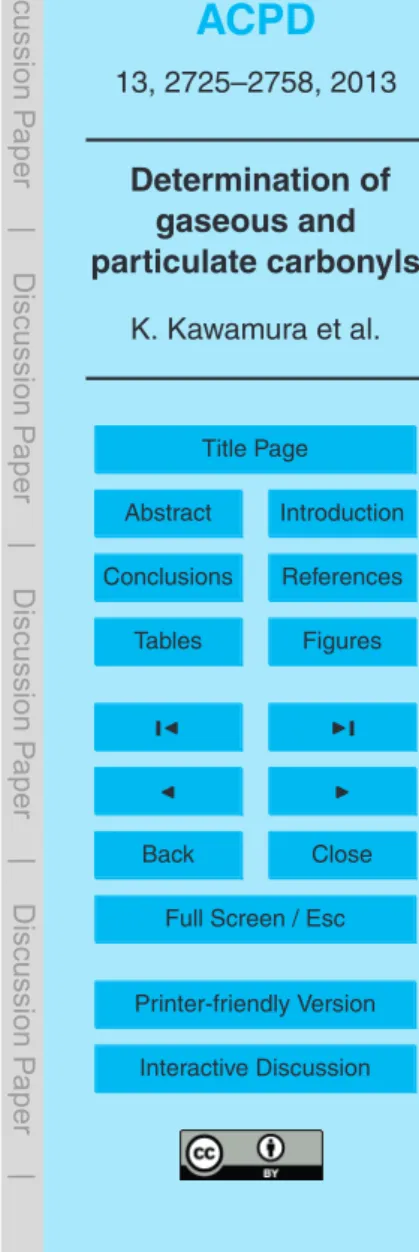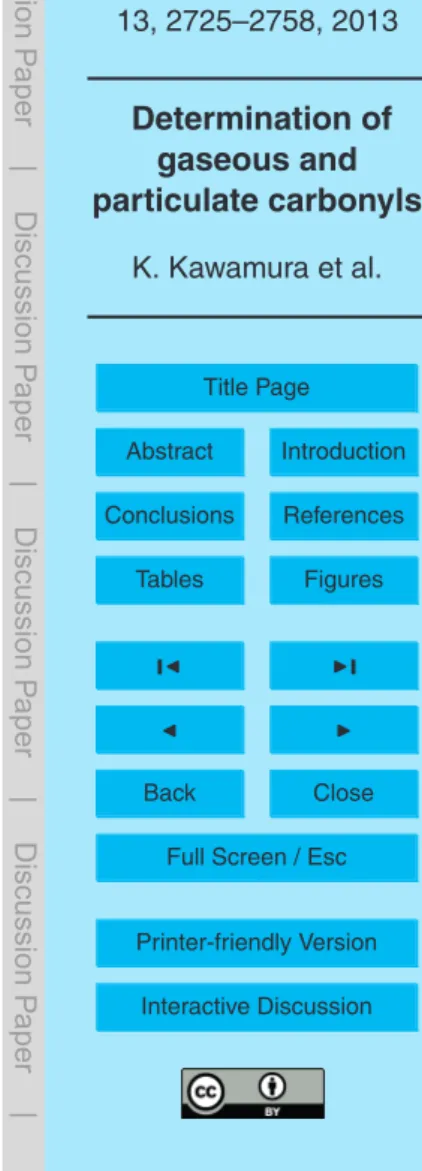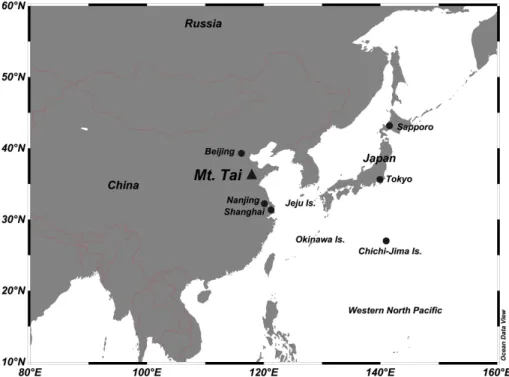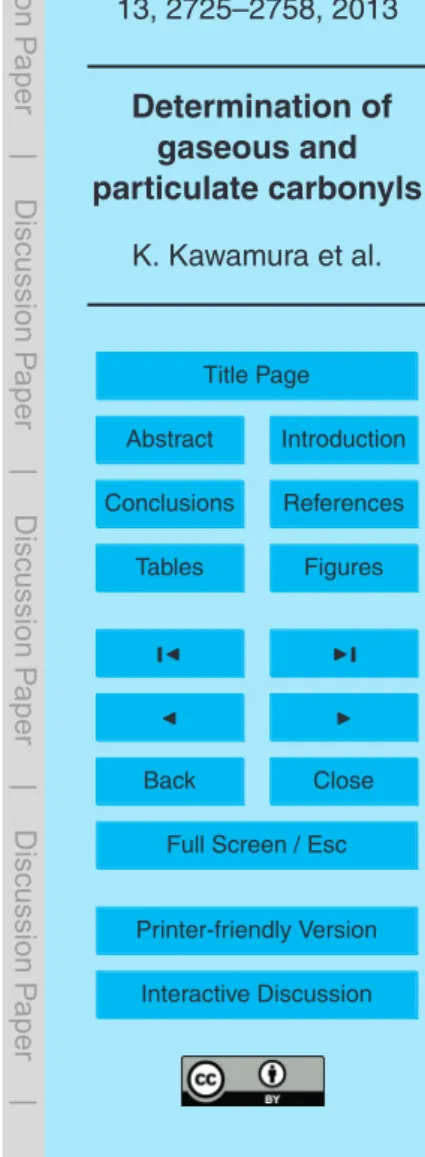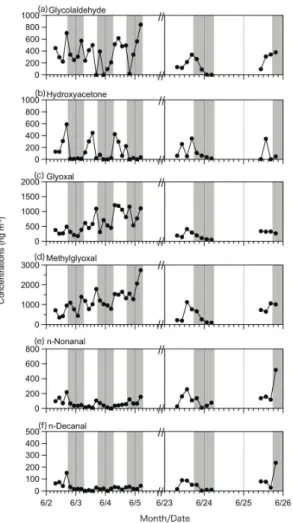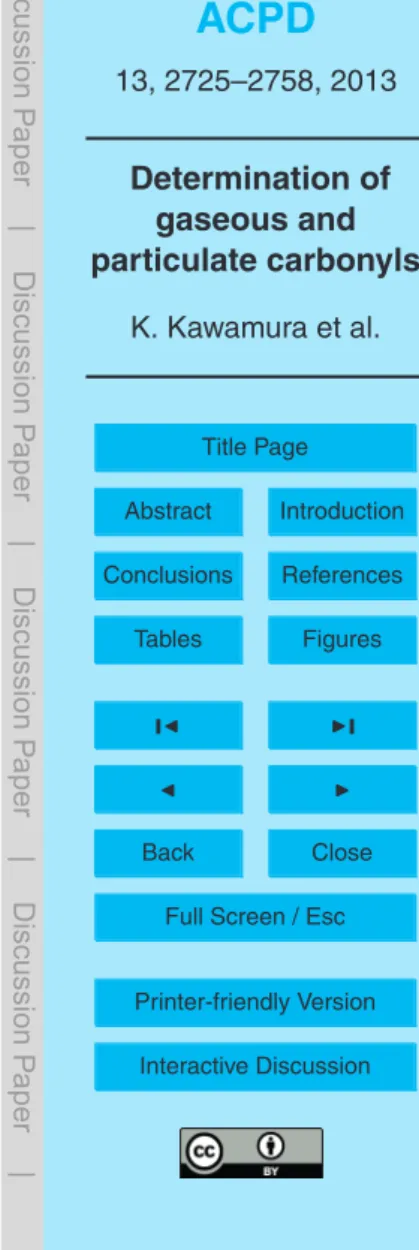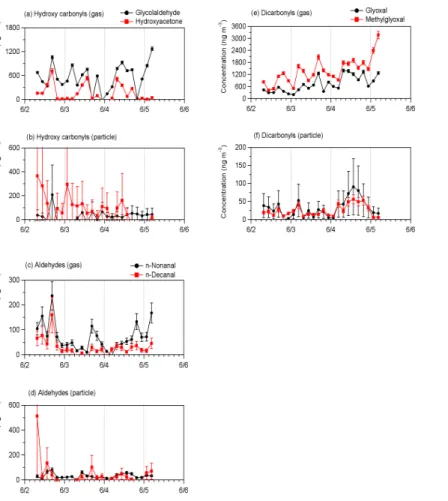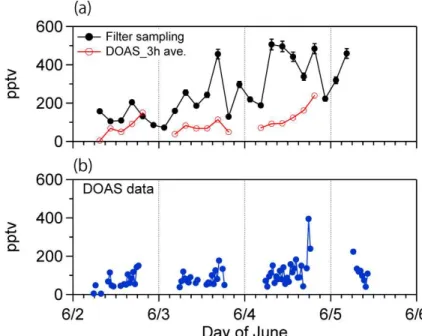ACPD
13, 2725–2758, 2013Determination of gaseous and particulate carbonyls
K. Kawamura et al.
Title Page
Abstract Introduction
Conclusions References
Tables Figures
◭ ◮
◭ ◮
Back Close
Full Screen / Esc
Printer-friendly Version Interactive Discussion
Discussion
P
a
per
|
Dis
cussion
P
a
per
|
Discussion
P
a
per
|
Discussio
n
P
a
per
|
Atmos. Chem. Phys. Discuss., 13, 2725–2758, 2013 www.atmos-chem-phys-discuss.net/13/2725/2013/ doi:10.5194/acpd-13-2725-2013
© Author(s) 2013. CC Attribution 3.0 License.
Atmospheric Chemistry and Physics Discussions
This discussion paper is/has been under review for the journal Atmospheric Chemistry and Physics (ACP). Please refer to the corresponding final paper in ACP if available.
Determination of gaseous and particulate
carbonyls (glycolaldehyde,
hydroxyacetone, glyoxal, methylglyoxal,
nonanal and decanal) in the atmosphere
at Mt. Tai
K. Kawamura1, K. Okuzawa1,2, S. G. Aggarwal1, H. Irie3,4, Y. Kanaya3, and Z. Wang5
1
Institute of Low Temperature Science, Hokkaido University, Sapporo 060-0819, Japan
2
Graduate School of Environmental Science, Hokkaido University, Sapporo, Hokkaido, 060-0810, Japan
3
Research Institute for Global Change, Japan Agency for Marine-Earth Science and Technology, Kanagawa 236-0001, Japan
4
Center for Environmental Remote Sensing, Chiba University, Chiba 263-8522, Japan
5
ACPD
13, 2725–2758, 2013Determination of gaseous and particulate carbonyls
K. Kawamura et al.
Title Page
Abstract Introduction
Conclusions References
Tables Figures
◭ ◮
◭ ◮
Back Close
Full Screen / Esc
Printer-friendly Version Interactive Discussion
Discussion
P
a
per
|
Dis
cussion
P
a
per
|
Discussion
P
a
per
|
Discussio
n
P
a
per
|
Received: 10 January 2013 – Accepted: 21 January 2013 – Published: 25 January 2013 Correspondence to: K. Kawamura (kawamura@lowtem.hokudai.ac.jp)
ACPD
13, 2725–2758, 2013Determination of gaseous and particulate carbonyls
K. Kawamura et al.
Title Page
Abstract Introduction
Conclusions References
Tables Figures
◭ ◮
◭ ◮
Back Close
Full Screen / Esc
Printer-friendly Version Interactive Discussion
Discussion
P
a
per
|
Dis
cussion
P
a
per
|
Discussion
P
a
per
|
Discussio
n
P
a
per
|
Abstract
Gaseous and particulate semi-volatile carbonyl compounds were determined every three hours in the atmosphere of Mount Tai (elevation, 1534 m) in the North China Plain during 2–5, 23–24 and 25 June, 2006 under a clear sky condition. Using two-step filter cartridge in a series, particulate carbonyls were first collected on a quartz
5
filter and then gaseous carbonyls were collected on a quartz filter impregnated with O-benzylhydroxylamine (BHA). After the two-step derivatization with BHA and N,O-bis(trimethylsilyl)trifluoroacetamide (BSTFA), carbonyl derivatives were measured us-ing a gas chromatography. The gaseous concentrations were obtained as follow: glyco-laldehyde (range 0–1271 ng m−3, average 555 ng m−3), hydroxyacetone (0–707 ng m−3,
10
163 ng m−3
), glyoxal (198–1396 ng m−3
, 720 ng m−3
), methylglyoxal (410–3170 ng m−3
, 1376 ng m−3), n-nonanal (0–236 ng m−3, 71 ng m−3), and n-decanal (0–159 ng m−3, 31 ng m−3). These concentrations are among the highest ever reported in the urban and forest atmosphere. We found that gaseous carbonyls are more than 10 times more abundant than particulate carbonyls. Time-resolved variations of carbonyls did
15
not show any a clear diurnal pattern, except for hydroxyacetone. We found that gly-oxal, methylglyoxal and glycolaldehyde positively correlated with levoglucosan (a tracer of biomass burning), suggesting that a contribution from field burning of agricultural wastes (wheat crops) is significant for the bifunctional carbonyls in the atmosphere of Mt. Tai. Upward transport of the pollutants to the mountaintop from the low lands in
20
the North China Plain is a major process to control the distributions of carbonyls in the upper atmosphere over Mt. Tai.
1 Introduction
Bi-functional carbonyls such as glyoxal and methylglyoxal are semi-volatile and abun-dantly present as gaseous phase in the urban and forest atmosphere (Matsunaga
25
ACPD
13, 2725–2758, 2013Determination of gaseous and particulate carbonyls
K. Kawamura et al.
Title Page
Abstract Introduction
Conclusions References
Tables Figures
◭ ◮
◭ ◮
Back Close
Full Screen / Esc
Printer-friendly Version Interactive Discussion
Discussion
P
a
per
|
Dis
cussion
P
a
per
|
Discussion
P
a
per
|
Discussio
n
P
a
per
|
2012; Okuzawa et al., 2007). They are produced during the oxidation of volatile or-ganic compounds (VOC) released by anthropogenic activities, biogenic processes and burning sources either via combustion and photochemical processes (Carlier et al., 1986; Christensen et al., 2000; Grosjean et al., 2002). In particular, hydroxyacetone and α-dicarbonyls (glyoxal and methylglyoxal) are produced by the oxidation of
aro-5
matic hydrocarbons and hydroxy carbonyls (Smith et al., 1998, 1999; Kleindienst et al., 2004). Isoprene also produces carbonyls by the oxidation with OH radicals (Carlier et al., 1986; Spaulding et al., 2003; Carlton et al., 2006, 2009). Some carbonyls such asα-dicarbonyls that are produced by gas phase oxidation of VOC can also be present as aerosols (Kawamura and Yasui, 2005; Kawamura et al., 2010) due to their high
ef-10
fective Henry’s law constant (e.g.>3.6×105M atm−1for glyoxal) (Betterton and Hoff -mann, 1988; Carlton et al., 2007) and the formation of hydrate (gem-diol) (Matsunaga and Kawamura, 2000) and/or oligomer formation of dicarbonyls in aerosols (Loeffler et al., 2006). Aqueous-phase reactive uptake of dicarbonyls has been proposed as a source of organic aerosol (Fu et al., 2008, 2009).
15
Some dicarbonyls can serve as precursors of oxalic acid that is the most abun-dant organic species present in atmospheric particles (Kawamura and Ikushima, 1993; Kawamura and Usukura, 1993; Kawamura and Yasui, 2005).α-Dicarbonyls such as glyoxal can form oligomers (Liggio et al., 2005; Loeffler et al., 2006). Oxalic acid and other small dicarboxylic acids are produced in cloud and/or aerosol by aqueous phase
20
reactions (Carlton et al., 2007; Legrand et al., 2007). The reaction products of car-bonyls are water-soluble and thus act as cloud condensation nuclei (CCN). They may play a role in the radiative forcing of aerosols and affect on climate change.
Bifunctional carbonyls such as glyxolaldehyde, hydroxyacetone, glyoxal and methyl-glyoxal have been studied in the urban atmosphere as abundant gaseous components
25
ACPD
13, 2725–2758, 2013Determination of gaseous and particulate carbonyls
K. Kawamura et al.
Title Page
Abstract Introduction
Conclusions References
Tables Figures
◭ ◮
◭ ◮
Back Close
Full Screen / Esc
Printer-friendly Version Interactive Discussion
Discussion
P
a
per
|
Dis
cussion
P
a
per
|
Discussion
P
a
per
|
Discussio
n
P
a
per
|
mountaintop of Mt. Tai in the North China Plain during early summer when field burn-ing of agricultural wastes was extensive. Both gaseous and particulate carbonyls were collected every three hours and determined using a capillary gas chromatography after two-step derivatization. Here, we report the time-resolved variations of glycolaldehyde, hydroxyacetone, glyoxal, methylglyoxal, nonanal and decanal (chemical structures are
5
shown in Fig. 1) and discuss their sources and formation processes in the free tropo-sphere.
The data of glyoxal will be compared with those obtained by the in situ measurements by MAX-DOAS at the foothill of Mt. Tai. The data of bifunctional carbonyls will be also compared with oxalic and glyoxylic acids determined in the aerosol samples that were
10
simultaneously collected at the summit of Mt. Tai to discuss the photochemical linkage between gaseous bifunctional carbonyls and oxalic acid, the latter is the most abundant aerosol organic species.
2 Experimental
Mt. Tai (elevation: 1534 m a.s.l., 36.25◦N and 117.10◦E) is located in Shandong
15
Province, Central East China (CEC). It is an independent peak in the CEC region (see Fig. 2 for map) and the mountaintop often stays within the free troposphere at night (Takigawa et al., unpublished results). As part of the Mount Tai eXperiment 2006 cam-paign (MTX2006) in early summer (Kanaya et al., 2013), three-hour samplings were performed for gaseous and particulate semi-volatile carbonyls from 2–5, 23–24 and
20
25 June 2006 at the balcony of two-story building of the observatory (∼10 m a.g.l.) on
the top of Mt. Tai.
Figure 3 presents outlines of the sampling system using two-step filters and URG filter pack with a flow rate of 16.7 L min−1. Particulate carbonyls were collected on a quartz filter (1st filter) whereas gaseous carbonyls were collected on a quartz
fil-25
ACPD
13, 2725–2758, 2013Determination of gaseous and particulate carbonyls
K. Kawamura et al.
Title Page
Abstract Introduction
Conclusions References
Tables Figures
◭ ◮
◭ ◮
Back Close
Full Screen / Esc
Printer-friendly Version Interactive Discussion
Discussion
P
a
per
|
Dis
cussion
P
a
per
|
Discussion
P
a
per
|
Discussio
n
P
a
per
|
samples (36 samples for gas and particles, respectively) were stored in a clean glass vial (50 mL) with a Teflon-lined screw cap at−20◦C in a freezer room. Before the
sam-ple collection, quartz filters (45 cm in diameter) were combusted to remove organic con-taminants and stored in the clean vials. For the collection of gaseous phase carbonyls, quartz filter was impregnated with BHA reagent in acetonitrile (Matsunaga et al., 2004)
5
and stored in a clean glass vial until the sampling.
In the laboratory, the quartz filter that collect particulate bifunctional carbonyls was extracted with methylene chloride/acetonitrile (1 : 1) mixture and the extracts were con-centrated with a rotary evaporator under vacuum to which 2 mL of BHA solution (4 % in acetonitrile) were added to derive benzylhydroxy oximes (HB oximes) of carbonyls and
10
stood for 24 h at room temperature. The HB oximes were dried using a rotary evap-orator under vacuum and then dissolved in ethyl acetate. The BHA-impregnated filter that collect gaseous carbonyls was handled as follows. BHA solution in acetonitrile was added to the filter, which was stood for 24 h at room temperature to complete the formation of the HB oxime derivatives The derivatives were extracted with acetonitrile,
15
concentrated under vacuum and then dissolved in ethyl acetate. The extracts were fur-ther concentrated under nitrogen flow and the hydroxyl group of HB oxime was reacted with N,O-bis(trimethylsilyl)trifluoroacetamide (BSTFA, 50 µL) at 60◦C for 1 h to derive the TMS ether. In the case of hydroxy aldehyde (e.g. glycolaldehyde), reactions were preceded as follows:
ACPD
13, 2725–2758, 2013Determination of gaseous and particulate carbonyls
K. Kawamura et al.
Title Page
Abstract Introduction
Conclusions References
Tables Figures
◭ ◮
◭ ◮
Back Close
Full Screen / Esc
Printer-friendly Version Interactive Discussion
Discussion
P
a
per
|
Dis
cussion
P
a
per
|
Discussion
P
a
per
|
Discussio
n
P
a
per
|
After the two-step derivatization with BHA and BSTFA, the carbonyl BH oxime deriva-tives were determined using a gas chromatography (Matsunaga et al., 2003; Okuzawa et al., 2007).
In order to check the recoveries of gaseous and particulate carbonyls in tripli-cate, 6 authentic carbonyls (glycolaldehyde, hydroxyacetone, glyoxal, methylglyoxal,
5
n-nonanal, n-decanal, glyoxal and methylglyoxal) were added onto the BHA impreg-nated quartz filter and neutral quartz filter following the analytical procedures described above. Table 1 shows the recoveries of carbonyls that were spiked to the BHA impreg-nated filter. The results indicate that the recoveries of gaseous carbonyls are more than 80 %, except for glycoladehydes (66 %). In contrast, the recoveries of carbonyls
10
spiked to neutral filter that collect particles were more than 86 % except for glyco-laldehyde (54 %) and glyoxal (50 %) (see Table 2). Some semivolatile aldehydes such as glycolaldehydes and glyoxal may be in part evaporated from the aerosol particles and trapped on the BHA impregnated filter during the sampling. Thus, gaseous car-bonyls may potentially be overestimated whereas particulate carcar-bonyls may be
under-15
estimated. However, glyoxal and some other bifunctional carbonyls can form hydrated forms (e.g. gem-diol) and oligomers, which partition into particles. Thus, the recoveries of particulate carbonyls may be better than those obtained for authentic carbonyls from the neutral filter (Table 2). The concentrations of carbonyls reported here are corrected for the blanks.
20
During the MTX2006 campaign, the Multi-Axis Differential Optical Absorption Spec-troscopy (MAX-DOAS) system was also operated at the top of Mt. Tai (Inomata et al., 2008; Irie et al., 2008). The MAX-DOAS system has a telescope unit with five tele-scopes, which were all directed south, but the elevation angles were fixed at−5◦, 5◦,
10◦, 20◦, and 30◦, respectively. The telescope with an elevation angle of −5◦ looked 25
ACPD
13, 2725–2758, 2013Determination of gaseous and particulate carbonyls
K. Kawamura et al.
Title Page
Abstract Introduction
Conclusions References
Tables Figures
◭ ◮
◭ ◮
Back Close
Full Screen / Esc
Printer-friendly Version Interactive Discussion
Discussion
P
a
per
|
Dis
cussion
P
a
per
|
Discussion
P
a
per
|
Discussio
n
P
a
per
|
30 min. The measured five different spectra were projected onto the 2-D CCD detector, simultaneously. In a 30-min cycle, two different wavelength regions of 310–377 nm (for the first 15 min) and 425–490 nm (for the last 15 min) were measured alternatively. The spectral resolution (FWHM) was estimated to be about 0.2–0.3 nm. The spectral fitting window of 436–457 nm was analyzed by the DOAS method and then the vertical profile
5
retrieval was done to retrieve vertical profiles of glyoxal mixing ratio in the lower tropo-sphere (Inomata et al., 2008; Irie et al., 2008). The mean glyoxal volume mixing ratios in the layer of 1–2 km above the ground are used in this study. Although the altitude is different from that for the direct sampling measurements at the summit of Mt. Tai, MAX-DOAS glyoxal data can be used to compare with the temporal variations that are
10
obtained from the filter sampling and GC measurement.
The meteorological parameters (temperature, relative humidity, wind direc-tion/speeds and precipitation) as well as air mass trajectories and fire spots are pre-sented in Kawamura et al. (2013). Briefly, the ambient temperature increased up to 24◦C in daytime and decreased down to 8◦C at night. The relative humidity increased
15
from ca. 50 % in daytime to>95 % at night. During early June, extensive fire spots were observed from a space (Kawamura et al., 2013) in the North China Plain, in which field burning of agricultural waste (harvested wheat straws) was densely observed (Kanaya et al., 2013).
3 Result and discussion
20
3.1 Concentrations and distributions of 6 carbonyls
We detected 6 carbonyls (glycolaldehyde, hydroxyacetone, glyoxal, methylglyoxal,n -nonanal andn-decanal) in the gas and particle phases in the atmosphere of Mt. Tai. Table 3 shows average concentrations of these carbonyls with concentration ranges. Among the gaseous carbonyls detected, methylglyoxal was found as the most
abun-25
ACPD
13, 2725–2758, 2013Determination of gaseous and particulate carbonyls
K. Kawamura et al.
Title Page
Abstract Introduction
Conclusions References
Tables Figures
◭ ◮
◭ ◮
Back Close
Full Screen / Esc
Printer-friendly Version Interactive Discussion
Discussion
P
a
per
|
Dis
cussion
P
a
per
|
Discussion
P
a
per
|
Discussio
n
P
a
per
|
third of glycolaldehyde. Straight-chain aldehydes such as nonanal and decanal are several times less abundant than methylglyoxal and glyoxal. In contrast, hydroxyaceton was the most abundant carbonyls detected in the particle phase, followed byn-nonanal andn-decanal. Methylglyoxal and glyoxal are among the least abundant carbonyls in the particles. We found that gaseous carbonyls are several times more abundant than
5
particle phase carbonyls in the atmosphere of Mt. Tai, except for decanal (see Table 3). Higher concentrations of carbonyls in gas phase than in particles have been reported from urban Tokyo (Okuzawa et al., 2007) and from the forest atmosphere (Matsunaga et al., 2004; Ieda et al., 2006) using a denuder technique for the collection of gaseous carbonyls.
10
Interestingly, an opposite trend was obtained in semi-urban Saitama, located ca. 30 km northwest of the metropolitan Tokyo area, with higher concentrations of car-bonyls in particles (several times higher in particles than gas phase) (Ortiz et al., 2006), in which particulate carbonyls are slightly higher than our results but gaseous carbonyls are significantly lower than ours (e.g. concentration of gaseous
methylgly-15
oxal in Saitama is ca. 50 time lower than that of Mt. Tai). In the study of Saitama, PFBHA-coated denuder was used for the collection of gaseous carbonyls whereas PFBHA-impregnated filter was used for the collection of particulate carbonyls using a potassium iodide annular denuder (Ortiz et al., 2006).
Table 3 compares the average concentrations of carbonyls with those reported from
20
other sampling sites. Concentrations of gaseous hydroxy carbonyls (glycolaldehyde and hydroxyacetone) in the Mt. Tai atmosphere are lower (ca. half) than those reported in urban Tokyo (Okuzawa et al., 2007) but 3–4 times higher than those from the atmo-sphere in the forest of Moshiri, Hokkaido, Japan (Matsunaga et al., 2004). In contrast, concentrations ofα-dicarbonyls in Mt. Tai are twice higher than those from the Tokyo
25
ACPD
13, 2725–2758, 2013Determination of gaseous and particulate carbonyls
K. Kawamura et al.
Title Page
Abstract Introduction
Conclusions References
Tables Figures
◭ ◮
◭ ◮
Back Close
Full Screen / Esc
Printer-friendly Version Interactive Discussion
Discussion
P
a
per
|
Dis
cussion
P
a
per
|
Discussion
P
a
per
|
Discussio
n
P
a
per
|
mast exists (Matsunaga et al., 2004). On the other hand, concentrations of particulate carbonyls in the Mt. Tai aerosols are 3–4 times higher than the forest aerosols from Moshiri (Matsunaga et al., 2004), except for glyoxal (almost same) and methylglyoxal (twice lower than Moshiri).
It is of interest to note that concentrations of gaseous α-dicarbonyls in Mt. Tai are
5
much higher than those (670 ng m−3 for methylglyoxal and 160 ng m−3 for glyoxal) re-ported in heavily polluted Xi’an, China during summer (Dai et al., 2012), but much lower than those (4960 ng m−3 and 1880 ng m−3, respectively) reported in semi-rural area from Rome, Italy (Possanzini et al., 2007). In the latter case, a potassium iodide-coated annular denuder was placed upstream of the DNPH-iodide-coated silica gel Sep-Pak
10
cartridge (Possanzini et al., 2007).
3.2 Time-resolved variations of carbonyl compounds
Figure 4 presents time-resolved variations of 6 carbonyls in gas phase. In general, the concentrations of carbonyls did not show clear daytime maxima although hydrox-yacetone seems to maximize in daytime. These results are not consistent with the
15
observation from urban Tokyo, in which daytime maxima of glycolaldehyde, hydroxy-acetone, glyoxal and methylglyoxal have clearly been obtained together with the day-time maxima of oxidants (Okuzawa et al., 2007). These comparisons may suggest that the sources and formation pathways of bifunctional carbonyls in the atmosphere of Mt. Tai are not the same with those of the urban atmosphere. In the summit of Mt. Tai,
long-20
range transport may be more important than in situ photochemical production via the oxidation of various VOCs in the atmosphere. In the North Chain Plain, field burning of agricultural waste (wheat straw) is common in early summer after the harvesting of wheat (Kanaya et al., 2013) and biomass-burning products such as levoglucosan have been abundantly detected in the mountaintop aerosols during MTX 2006 campaign (Fu
25
et al., 2012).
ACPD
13, 2725–2758, 2013Determination of gaseous and particulate carbonyls
K. Kawamura et al.
Title Page
Abstract Introduction
Conclusions References
Tables Figures
◭ ◮
◭ ◮
Back Close
Full Screen / Esc
Printer-friendly Version Interactive Discussion
Discussion
P
a
per
|
Dis
cussion
P
a
per
|
Discussion
P
a
per
|
Discussio
n
P
a
per
|
r=0.82), methylglyoxal (r =0.78), and glycolaldehyde (r=0.63); levoglucosan data are from Fu et al. (2012). Figure 5 presents relationships between glyoxal and levoglu-cosan, and methylglyoxal and levoglucosan. These results suggest that bifunctional carbonyls except for hydroxyacetone are mainly derived from biomass burning in the North China Plain where field burning of wheat straws are extensively operated in the
5
early summer and the biomass burning plumes are transported to the mountaintop by upwind in daytime. However, there is no correlation between hydroxyacetone and levoglucosan (r=0.15). On the other hand, nonanal and decanal showed a weak neg-ative relationship with levoglucosan (r=0.19–0.20). These aldehydes may be derived from the plant emissions (Matsunaga et al., 2004).
10
Figure 6 presents comparison of gaseous and particulate carbonyls in the time-resolved variations in the Mt. Tai atmosphere for the period of 2–5 June 2006. The variations of particulate carbonyls did not show a diurnal trend, except forn-aldehydes (nonanal and decanal, see Fig. 6d) andα-dicarbonyls (glyoxal and methylglyoxal, see Fig. 6f) that showed daytime maxima on June 4. As already stated above, most
car-15
bonyls are present as gases in the atmosphere of Mt. Tai, although particulate concen-trations of nonanal and decanal are sometime similar to those of gaseous forms.
3.3 MAX-DOAS measurement of glyoxal and its comparison to filter sampling/GC measurements of gaseous glyoxal
In Fig. 7, the glyoxal mixing ratios derived from MAX-DOAS observations are
plot-20
ted as a function of the sampling time to compare with those obtained from the filter sampling/GC determination. The MAX-DOAS data represent a mean concentration of glyoxal for the layer of 1–2 km above the ground surface as mentioned above. Although the altitude and area of MAX-DOAS observation are different from those of filter sam-pling site (elevation 1534 m a.s.l.) and thus could lead to a systematic difference in the
25
ACPD
13, 2725–2758, 2013Determination of gaseous and particulate carbonyls
K. Kawamura et al.
Title Page
Abstract Introduction
Conclusions References
Tables Figures
◭ ◮
◭ ◮
Back Close
Full Screen / Esc
Printer-friendly Version Interactive Discussion
Discussion
P
a
per
|
Dis
cussion
P
a
per
|
Discussion
P
a
per
|
Discussio
n
P
a
per
|
in the atmosphere of Mt. Tai. However, the mixing ratios of MAX-DOAS glyoxal are ca. 5 times lower than those of glyoxal determined by the filter sampling/GC method. This may suggest that glyoxal levels in the atmosphere of Mt. Tai are much higher than those in the near-ground atmosphere over the North China Plain. Plain possibly by photochemical production of glyoxal in the upper atmosphere. Further studies are
5
needed to better understand the vertical profile of glyoxal over the North China Plain.
3.4 Comparison of gaseousα-dicarbonyls (this study) with particulate α-dicarbonyls determined in the TSP samples
Because the accuracy of particulate carbonyls determined in this study is not high enough to discuss gas/particle partitioning (see Fig. 6), we use here the data sets of
10
α-dicarbonyls obtained from the analyses of the TSP samples collected every 3 h si-multaneously at the same sampling site of Mt. Tai and analyzed using dibutoxy deriva-tives and GC determination (Kawamura et al., 2013). Figure 9a shows relationship between gaseous glyoxal determined in this study and particulate glyoxal determined in the aerosol filter samples collected using a high volume air sampler at the summit
15
of Mt. Tai. A good positive correlation was found between the two data sets (correla-tion coefficient: r =0.83). We also found that gaseous glyoxal concentrations are ca. 20 times higher than those of particulate glyoxal, again indicating that major portion of this α-dicarbonyl is mostly present as gas in the mountain atmosphere. This con-clusion is consistent with previous studies (Matsunaga et al., 2004; Ieda et al., 2006;
20
Okuzawa et al., 2007). Although similar positive correlation was obtained for methylgly-oxal (Fig. 9b), correlation coefficient (r=0.70) is smaller than that of glyoxal (r=0.83). Although gas-phase carbonyls are always more abundant than particle-phase car-bonyls throughout the campaign, we detected the diurnal changes in the gas/particle partitioning of glyoxal as shown in Fig. 10. The gas/particle ratios of glyoxal were
25
ACPD
13, 2725–2758, 2013Determination of gaseous and particulate carbonyls
K. Kawamura et al.
Title Page
Abstract Introduction
Conclusions References
Tables Figures
◭ ◮
◭ ◮
Back Close
Full Screen / Esc
Printer-friendly Version Interactive Discussion
Discussion
P
a
per
|
Dis
cussion
P
a
per
|
Discussion
P
a
per
|
Discussio
n
P
a
per
|
is higher. However, we did not found a clear diurnal variation in the gas/particle ratios of methylglyoxal (data are not shown as a figure).
3.5 Gaseous glyoxal and methylglyoxal as potential precursors of oxalic and glyoxylic acids in aerosols
Oxalic acid is one of the most abundant organic species in aerosol particles. This
or-5
ganic acid can be emitted from fossil fuel combustion (Kawamura and Kaplan, 1987; Ho et al., 2007) and biomass burning (Legrand and de Angelis, 1996; Narukawa et al., 1999; Kundu et al., 2010), however, most important source of oxalic acid is secondary production in the atmosphere via photochemical oxidation of various precursors (Er-vens et al., 2004, 2008; Kawamura and Yasui, 2005; Carlton et al., 2007; Kawamura
10
et al., 2010). Glyoxal and methylglyoxal are important precursors of oxalic acid and gly-oxylic acid (Kawamura et al., 1996; Warneck, 2003; Ervens et al., 2011). Interestingly, we found a good correlation (r =0.75) between gaseous glyoxal concentrations and particulate oxalic acid concentrations in the Mt. Tai atmosphere (see Fig. 10a). Much stronger correlation (r=0.89) was obtained between gaseous methylglyoxal and
par-15
ticulate oxalic acid (Fig. 10b). These results may suggest that gaseousα-dicarbonyls are taken in the aerosols during gas/particle partioning and are subjected to aqueous aerosol phase oxidation to result in oxalic acid.
In order to evaluate the above idea, the concentration ratios were taken for combina-tions of possible gaseous precursor and particle phase product. The product/precursor
20
ratios for several combinations are plotted as a function of sampling time of 3 h. As shown in Fig. 11a, oxalic acid/glyoxal ratios increased at night when ambient temper-ature decreased and relative humidity increased. The nighttime peaks of the prod-uct/precursor ratios on 2–5 June support the aqueous phase production of oxalic acid (HOOC-COOH) by the oxidation of glyoxal (HCO-CHO) that is transferred from
25
ACPD
13, 2725–2758, 2013Determination of gaseous and particulate carbonyls
K. Kawamura et al.
Title Page
Abstract Introduction
Conclusions References
Tables Figures
◭ ◮
◭ ◮
Back Close
Full Screen / Esc
Printer-friendly Version Interactive Discussion
Discussion
P
a
per
|
Dis
cussion
P
a
per
|
Discussion
P
a
per
|
Discussio
n
P
a
per
|
suggest that glyoxal can be oxidized to result in glyoxylic acid (HCO-COOH) via the aqueous phase reaction (Warneck, 2003). Similar nighttime peaks were observed for 23–24 June data (Figures are not shown here). Further, we found the nighttime maxima of pyruvic acid/methylglyoxal ratios (the data are not shown as a figure), suggesting that pyruvic acid (CH3COCOOH) can be produced by the oxidation of methylglyoxal 5
(CH3COCHO).
These results support that the nighttime production of small organic acids from α -dicarbonyls occurs in the atmosphere over Mt. Tai probably via aqueous phase reaction in aerosols. Production of oxalic acid in nighttime aerosols has been reported in urban New Delhi, India (Miyazaki et al., 2009) and suburban areas of China (He and
Kawa-10
mura, 2010) based on day/night observation of dicarboxylic acids, which has been interpreted by aqueous phase oxidation of precursor organics including glyoxylic acid, although the correlation analyses with dicarbonyls were not performed.
4 Summary and conclusions
Bifunctional carbonyls (glyoxal, methylglyoxal, glycolaldehyde and hydroxyacetone)
15
and n-aldehydes (nonanal and octanal) were studied in the gas phase and particles in the atmosphere at the summit of Mt. Tai (elevation, 1534 m) in the North China Plain during early summer. Gaseous phase carbonyls were found to be roughly ten times more abundant than particulate carbonyls. Methylglyoxal was found as the most abundant carbonyl followed by glyoxal and glycolaldehyde. Normal aldehydes were
20
less abundant. The carbonyls were measured every 3 h, however, we could not detect any clear daytime maximum in the diurnal variations, except for hydroxyacetone that showed a daytime peak. Instead, glyoxal, methylglyoxal and glycolaldehyde showed a positive correlation with levoglucosan, suggesting that the bifunctional carbonyls are mainly derived from biomass burning in the North China Plain where field burning
25
ACPD
13, 2725–2758, 2013Determination of gaseous and particulate carbonyls
K. Kawamura et al.
Title Page
Abstract Introduction
Conclusions References
Tables Figures
◭ ◮
◭ ◮
Back Close
Full Screen / Esc
Printer-friendly Version Interactive Discussion
Discussion
P
a
per
|
Dis
cussion
P
a
per
|
Discussion
P
a
per
|
Discussio
n
P
a
per
|
troposphere over Mt. Tai by the upwind. Gaseous carbonyls were found to correlate positively with oxalic acid in aerosols, suggesting a photochemical linkage between the carbonyls as precursors and oxalic acid as product. Further, the analyses of precur-sor/product ratios showed a decline in the ratios at nighttime. These results suggested that oxalic acid and glyoxylic acid are produced by the aqueous phase oxidation of
5
glyoxal in the aerosols in the upper troposphere during night when the ambient tem-perature decreases and relative humidity increases. This study emphasizes that bifunc-tional carbonyls are important atmospheric components that can act as precursors of secondary organic aerosols via heterogeneous reactions in aqueous aerosols.
Acknowledgements. This study was in part supported by the Japanese Ministry of
Educa-10
tion, Culture, Sports, Science and Technology (MEXT) through grant-in-aid Nos. 17340166, 19204055 and 24221001. We also acknowledge the financial support by the Global Environ-ment Research Fund (B-051) of the Ministry of the EnvironEnviron-ment, Japan for the shipping of the instruments to Mt. Tai.
References
15
Betterton, E. A. and Hoffmann, M. R.: Henry law constants of some environmentally important aldehydes, Environ. Sci. Technol., 22, 1415–1418, 1988.
Carlier, P., Hannachi, H., and Mouvier, G.: The chemistry of carbonyl-compounds in the atmo-sphere – a review, Atmos. Environ., 20, 2079–2099, 1986.
Carlton, A. G., Turpin, B. J., Lim, H. J., Altieri, K. E., and Seitzinger, S.: Link between isoprene 20
and secondary organic aerosol (SOA): pyruvic acid oxidation yields low volatility organic acids in clouds, Geophys. Res. Lett., 33, L06822, doi:10.1029/2005gl025374, 2006.
Carlton, A. G., Turpin, B. J., Altieri, K. E., Seitzinger, S., Reff, A., Lim, H. J., and Ervens, B.: Atmospheric oxalic acid and SOA production from glyoxal: results of aqueous photooxidation experiments, Atmos. Environ., 41, 7588–7602, 2007.
25
ACPD
13, 2725–2758, 2013Determination of gaseous and particulate carbonyls
K. Kawamura et al.
Title Page
Abstract Introduction
Conclusions References
Tables Figures
◭ ◮
◭ ◮
Back Close
Full Screen / Esc
Printer-friendly Version Interactive Discussion
Discussion
P
a
per
|
Dis
cussion
P
a
per
|
Discussion
P
a
per
|
Discussio
n
P
a
per
|
Christensen, C. S., Skov, H., Nielsen, T., and Lohse, C.: Temporal variation of carbonyl com-pound concentrations at a semi-rural site in Denmark, Atmos. Environ., 34, 287–296, 2000. Dai, W. T., Ho, S. S. H., Ho, K. F., Liu, W. D., Cao, J. J., and Lee, S. C.: Seasonal and diurnal
variations of mono- and di-carbonyls in Xi’an, China, Atmos. Res., 113, 102–112, 2012. Ervens, B., Feingold, G., Frost, G. J., and Kreidenweis, S. M.: A modeling study of aqueous pro-5
duction of dicarboxylic acids: 1. Chemical pathways and speciated organic mass production, J. Geophys. Res.-Atmos., 109, D15205, doi:10.1029/2003jd004387, 2004.
Ervens, B., Carlton, A. G., Turpin, B. J., Altieri, K. E., Kreidenweis, S. M., and Feingold, G.: Sec-ondary organic aerosol yields from cloud-processing of isoprene oxidation products, Geo-phys. Res. Lett., 35, GL031828, doi:10.1029/2007GL031828, 2008.
10
Ervens, B., Turpin, B. J., and Weber, R. J.: Secondary organic aerosol formation in cloud droplets and aqueous particles (aqSOA): a review of laboratory, field and model studies, Atmos. Chem. Phys., 11, 11069–11102, doi:10.5194/acp-11-11069-2011, 2011.
Fu, P. Q., Kawamura, K., Chen, J., Li, J., Sun, Y. L., Liu, Y., Tachibana, E., Aggarwal, S. G., Okuzawa, K., Tanimoto, H., Kanaya, Y., and Wang, Z. F.: Diurnal variations of organic molec-15
ular tracers and stable carbon isotopic composition in atmospheric aerosols over Mt. Tai in the North China Plain: an influence of biomass burning, Atmos. Chem. Phys., 12, 8359– 8375, doi:10.5194/acp-12-8359-2012, 2012.
Fu, T.-M., Jacob, D. J., Wittrock, F., Burrows, J. P., Vrekoussis, M., and Henze, D. K.: Global bud-gets of atmospheric glyoxal and methylglyoxal, and applications for formation of secondary 20
organic aerosols, J. Geophys. Res.-Atmos., 113, D15303, doi:10.1029/2007JD009505, 2008.
Fu, T. M., Jacob, D. J., and Heald, C. L.: Aqueous-phase reactive uptake of dicarbonyls as a source of organic aerosol over eastern North America, Atmos. Environ., 43, 1814–1822, 2009.
25
Grosjean, D., Grosjean, E., and Moreira, L. F. R.: Speciated ambient carbonyls in Rio de Janeiro, Brazil, Environ. Sci. Technol., 36, 1389–1395, 2002.
He, N. and Kawamura, K.: Distributions and diurnal changes of low molecular weight organic acids and alpha-dicarbonyls in suburban aerosols collected at Mangshan, North China, Geochem. J., 44, E17–E22, 2010.
30
ACPD
13, 2725–2758, 2013Determination of gaseous and particulate carbonyls
K. Kawamura et al.
Title Page
Abstract Introduction
Conclusions References
Tables Figures
◭ ◮
◭ ◮
Back Close
Full Screen / Esc
Printer-friendly Version Interactive Discussion
Discussion
P
a
per
|
Dis
cussion
P
a
per
|
Discussion
P
a
per
|
Discussio
n
P
a
per
|
Ieda, T., Kitamori, Y., Mochida, M., Hirata, R., Hirano, T., Inukai, K., Fujinuma, Y., and Kawa-mura, K.: Diurnal variations and vertical gradients of biogenic volatile and semi-volatile or-ganic compounds at the Tomakomai larch forest station in Japan, Tellus B, 58, 177–186, 2006.
Inomata, S., Tanimoto, H., Kameyama, S., Tsunogai, U., Irie, H., Kanaya, Y., and Wang, Z.: 5
Technical Note: Determination of formaldehyde mixing ratios in air with PTR-MS: laboratory experiments and field measurements, Atmos. Chem. Phys., 8, 273–284, doi:10.5194/acp-8-273-2008, 2008.
Irie, H., Kanaya, Y., Akimoto, H., Tanimoto, H., Wang, Z., Gleason, J. F., and Bucsela, E. J.: Validation of OMI tropospheric NO2 column data using MAX-DOAS measurements deep 10
inside the North China Plain in June 2006: Mount Tai Experiment 2006, Atmos. Chem. Phys., 8, 6577–6586, doi:10.5194/acp-8-6577-2008, 2008.
Kanaya, Y., Akimoto, H., Wang, Z.-F., Pochanart, P., Kawamura, K., Liu, Y., Li, J., Komazaki, Y., Irie, H., Pan, X.-L., Taketani, F., Yamaji, K., Tanimoto, H., Inomata, S., Kato, S., Suthawa-ree, J., Okuzawa, K., Wang, G., Aggarwal, S. G., Fu, P. Q., Wang, Y., and Zhuang, G.: 15
Overview of the Mt. Tai Experiments (MTX2006) in Central East China in June 2006: studies of significant regional air pollution, Atmos. Chem. Phys. Discuss., in review, 2013.
Kawamura, K. and Ikushima, K.: Seasonal changes in the distribution of dicarboxylic acids in the urban atmosphere, Environ. Sci. Technol., 27, 2227–2235, 1993.
Kawamura, K. and Kaplan, I. R.: Motor exhaust emissions as a primary source for dicarboxylic-20
acids in Los-Angeles ambient air, Environ. Sci. Technol., 21, 105–110, 1987.
Kawamura, K. and Usukura, K.: Distributions of low molecular weight dicarboxylic acids in the North Pacific aerosol samples, J. Oceanogr., 49, 271–283, 1993.
Kawamura, K. and Yasui, O.: Diurnal changes in the distribution of dicarboxylic acids, ketocar-boxylic acids and dicarbonyls in the urban Tokyo atmosphere, Atmos. Environ., 39, 1945– 25
1960, 2005.
Kawamura, K., Kasukabe, H., and Barrie, L. A.: Source and reaction pathways of dicarboxylic acids, ketoacids and dicarbonyls in arctic aerosols: one year of observations, Atmos. Envi-ron., 30, 1709–1722, 1996.
Kawamura, K., Kasukabe, H., and Barrie, L. A.: Secondary formation of water-soluble organic 30
ACPD
13, 2725–2758, 2013Determination of gaseous and particulate carbonyls
K. Kawamura et al.
Title Page
Abstract Introduction
Conclusions References
Tables Figures
◭ ◮
◭ ◮
Back Close
Full Screen / Esc
Printer-friendly Version Interactive Discussion
Discussion
P
a
per
|
Dis
cussion
P
a
per
|
Discussion
P
a
per
|
Discussio
n
P
a
per
|
Kawamura, K., Tachibana, E., Okuzawa, K., Aggarwal, S. G., Kanaya, Y., and Wang, Z. F.: High abundances of water-soluble dicarboxylic acids, ketocarboxylic acids and α-dicarbonyls in the mountain aerosols over the North China Plain during wheat burning season, Atmos. Chem. Phys. Discuss., in review, 2013.
Kleindienst, T. E., Conver, T. S., McIver, C. D., and Edney, E. O.: Determination of secondary 5
organic aerosol products from the photooxidation of toluene and their implications in ambient PM2.5, J. Atmos. Chem., 47, 79–100, 2004.
Kundu, S., Kawamura, K., Andreae, T. W., Hoffer, A., and Andreae, M. O.: Molecular distri-butions of dicarboxylic acids, ketocarboxylic acids and α-dicarbonyls in biomass burning aerosols: implications for photochemical production and degradation in smoke layers, At-10
mos. Chem. Phys., 10, 2209–2225, doi:10.5194/acp-10-2209-2010, 2010.
Legrand, M. and de Angelis, M.: Light carboxylic acids in Greenland ice: a record of past forest fires and vegetation emissions from the boreal zone, J. Geophys. Res.-Atmos., 101, 4129– 4145, 1996.
Legrand, M., Preunkert, S., Oliveira, T., Pio, C. A., Hammer, S., Gelencser, A., Kasper-Giebl, A., 15
and Laj, P.: Origin of C2-C5 dicarboxylic acids in the European atmosphere inferred from year-round aerosol study conducted at a west-east transect, J. Geophys. Res.-Atmos., 112, D23s07, doi:10.1029/2006jd008019, 2007.
Liggio, J., Li, S. M., and McLaren, R.: Heterogeneous reactions of glyoxal on particulate matter: identification of acetals and sulfate esters, Environ. Sci. Technol., 39, 1532–1541, 2005. 20
Loeffler, K. W., Koehler, C. A., Paul, N. M., and De Haan, D. O.: Oligomer formation in evapo-rating aqueous glyoxal and methyl glyoxal solutions, Environ. Sci. Technol., 40, 6318–6323, 2006.
Matsunaga, S. and Kawamura, K.: Determination of α- and β-hydroxycarbonyls and dicar-bonyls in snow and rain samples by GC/FID and GC/MS employing benzyl hydroxyl grime 25
derivatization, Anal. Chem., 72, 4742–4746, 2000.
Matsunaga, S., Mochida, M., and Kawamura, K.: Variation on the atmospheric concen-trations of biogenic carbonyl compounds and their removal processes in the northern forest at Moshiri, Hokkaido Island in Japan, J. Geophys. Res.-Atmos., 109, D04302, doi:10.1029/2003JD004100, 2004.
30
ACPD
13, 2725–2758, 2013Determination of gaseous and particulate carbonyls
K. Kawamura et al.
Title Page
Abstract Introduction
Conclusions References
Tables Figures
◭ ◮
◭ ◮
Back Close
Full Screen / Esc
Printer-friendly Version Interactive Discussion
Discussion
P
a
per
|
Dis
cussion
P
a
per
|
Discussion
P
a
per
|
Discussio
n
P
a
per
|
formation processes, J. Geophys. Res.-Atmos., 114, D19206, doi:10.1029/2009jd011790, 2009.
Narukawa, M., Kawamura, K., Takeuchi, N., and Nakajima, T.: Distribution of dicarboxylic acids and carbon isotopic compositions in aerosols from 1997 Indonesian forest fires, Geophys. Res. Lett., 26, 3101–3104, 1999.
5
Okuzawa, K., Mochida, M., Bendle, J., Wang, H., and Kawamura, K.: Diurnal variation of semi-volatile dicarbonyls and hydroxycarbonyls in the urban atmosphere, Chikyukagaku, Geo-chemistry, 41, 125–134, 2007.
Ortiz, R., Hagino, H., Sekiguchi, K., Wang, Q. Y., and Sakamoto, K.: Ambient air measurements of six bifunctional carbonyls in a suburban area, Atmos. Res., 82, 709–718, 2006.
10
Possanzini, M., Tagliacozzo, G., and Cecinato, A.: Ambient levels and sources of lower car-bonyls at Montelibretti, Rome (Italy), Water Air Soil Poll., 183, 447–454, 2007.
Simoneit, B. R. T.: A review of biomarker compounds as source indicators and tracers for air pollution, Environ. Sci. Pollut. Res., 6, 159–169, 1999.
Smith, D. F., McIver, C. D., and Kleindienst, T. E.: Primary product distribution from the reaction 15
of hydroxyl radicals with toluene at ppb NOx mixing ratios, J. Atmos. Chem., 30, 209–228, 1998.
Smith, D. F., Kleindienst, T. E., and McIver, C. D.: Primary product distributions from the reaction of OH withm-,p-xylene, 1,2,4- and 1,3,5-trimethylbenzene, J. Atmos. Chem., 34, 339–364, 1999.
20
Spaulding, R. S., Schade, G. W., Goldstein, A. H., and Charles, M. J.: Characterization of secondary atmospheric photooxidation products: evidence for biogenic and anthropogenic sources, J. Geophys. Res.-Atmos., 108, 4247, doi:10.1029/2002jd002478, 2003.
Volkamer, R., Martini, F. S., Molina, L. T., Salcedo, D., Jimenez, J. L., and Molina, M. J.: A miss-ing sink for gas-phase glyoxal in Mexico City: formation of secondary organic aerosol, Geo-25
phys. Res. Lett., 34, L19807, doi:10.1029/2007gl030752, 2007.
ACPD
13, 2725–2758, 2013Determination of gaseous and particulate carbonyls
K. Kawamura et al.
Title Page
Abstract Introduction
Conclusions References
Tables Figures
◭ ◮
◭ ◮
Back Close
Full Screen / Esc
Printer-friendly Version Interactive Discussion
Discussion
P
a
per
|
Dis
cussion
P
a
per
|
Discussion
P
a
per
|
Discussio
n
P
a
per
|
Table 1.Recoveries (%) of authentic carbonyls from BHA impregnated filter.
Compounds Recovery (%, Ave.±SD) Glycolaldehyde 65.9±22.3
Hydroxyacetone 82.0±17.3
n-Nonanal 89.1±1.9
ACPD
13, 2725–2758, 2013Determination of gaseous and particulate carbonyls
K. Kawamura et al.
Title Page
Abstract Introduction
Conclusions References
Tables Figures
◭ ◮
◭ ◮
Back Close
Full Screen / Esc
Printer-friendly Version Interactive Discussion
Discussion
P
a
per
|
Dis
cussion
P
a
per
|
Discussion
P
a
per
|
Discussio
n
P
a
per
|
Table 2.Recovery of authentic carbonyls from quartz filter.
Compounds Recovery (%, Ave.±SD) Glycolaldehyde 54.1±16.6
Hydroxyacetone 86.9±4.9
n-Nonanal 90.3±9.4
ACPD
13, 2725–2758, 2013Determination of gaseous and particulate carbonyls
K. Kawamura et al.
Title Page
Abstract Introduction
Conclusions References
Tables Figures
◭ ◮
◭ ◮
Back Close
Full Screen / Esc
Printer-friendly Version Interactive Discussion
Discussion
P
a
per
|
Dis
cussion
P
a
per
|
Discussion
P
a
per
|
Discussio
n
P
a
per
|
Table 3. Comparison of averaged carbonyl concentrations (ng m−3
) of this study with those reported in the urban, suburban and forest atmospheres.
Compounds This study (2–5 Jun)
Urban, Jul and Aug 20041 Tokyo, Japan
Suburban, Jul and Aug 20042 Saitama, Japan
Uryu Exp. Forest Aug 20023 Hokkaido, Japan
Tomakomai Forest Tower (22 m) Sep 20034 Hokkaido, Japan
Glycolaldehyde 555 1548 19 72 203
Hydroxyacetone 163 362 16 48 126
n-nonanal 71 584 – 102 –
n-decanal 31 123 – 44 –
Glyoxal 720 406 13 42 60
Methylglyoxal 1376 797 19 83 155
1Okuzawa et al. (2007). 2
ACPD
13, 2725–2758, 2013Determination of gaseous and particulate carbonyls
K. Kawamura et al.
Title Page
Abstract Introduction
Conclusions References
Tables Figures
◭ ◮
◭ ◮
Back Close
Full Screen / Esc
Printer-friendly Version Interactive Discussion
Discussion
P
a
per
|
Dis
cussion
P
a
per
|
Discussion
P
a
per
|
Discussio
n
P
a
per
|
ACPD
13, 2725–2758, 2013Determination of gaseous and particulate carbonyls
K. Kawamura et al.
Title Page
Abstract Introduction
Conclusions References
Tables Figures
◭ ◮
◭ ◮
Back Close
Full Screen / Esc
Printer-friendly Version Interactive Discussion
Discussion
P
a
per
|
Dis
cussion
P
a
per
|
Discussion
P
a
per
|
Discussio
n
P
a
per
|
ACPD
13, 2725–2758, 2013Determination of gaseous and particulate carbonyls
K. Kawamura et al.
Title Page
Abstract Introduction
Conclusions References
Tables Figures
◭ ◮
◭ ◮
Back Close
Full Screen / Esc
Printer-friendly Version Interactive Discussion
Discussion
P
a
per
|
Dis
cussion
P
a
per
|
Discussion
P
a
per
|
Discussio
n
P
a
per
|
ACPD
13, 2725–2758, 2013Determination of gaseous and particulate carbonyls
K. Kawamura et al.
Title Page
Abstract Introduction
Conclusions References
Tables Figures
◭ ◮
◭ ◮
Back Close
Full Screen / Esc
Printer-friendly Version Interactive Discussion
Discussion
P
a
per
|
Dis
cussion
P
a
per
|
Discussion
P
a
per
|
Discussio
n
P
a
per
|
ACPD
13, 2725–2758, 2013Determination of gaseous and particulate carbonyls
K. Kawamura et al.
Title Page
Abstract Introduction
Conclusions References
Tables Figures
◭ ◮
◭ ◮
Back Close
Full Screen / Esc
Printer-friendly Version Interactive Discussion
Discussion
P
a
per
|
Dis
cussion
P
a
per
|
Discussion
P
a
per
|
Discussio
n
P
a
per
|
ACPD
13, 2725–2758, 2013Determination of gaseous and particulate carbonyls
K. Kawamura et al.
Title Page
Abstract Introduction
Conclusions References
Tables Figures
◭ ◮
◭ ◮
Back Close
Full Screen / Esc
Printer-friendly Version Interactive Discussion
Discussion
P
a
per
|
Dis
cussion
P
a
per
|
Discussion
P
a
per
|
Discussio
n
P
a
per
|
ACPD
13, 2725–2758, 2013Determination of gaseous and particulate carbonyls
K. Kawamura et al.
Title Page
Abstract Introduction
Conclusions References
Tables Figures
◭ ◮
◭ ◮
Back Close
Full Screen / Esc
Printer-friendly Version Interactive Discussion
Discussion
P
a
per
|
Dis
cussion
P
a
per
|
Discussion
P
a
per
|
Discussio
n
P
a
per
|
ACPD
13, 2725–2758, 2013Determination of gaseous and particulate carbonyls
K. Kawamura et al.
Title Page
Abstract Introduction
Conclusions References
Tables Figures
◭ ◮
◭ ◮
Back Close
Full Screen / Esc
Printer-friendly Version Interactive Discussion
Discussion
P
a
per
|
Dis
cussion
P
a
per
|
Discussion
P
a
per
|
Discussio
n
P
a
per
|
ACPD
13, 2725–2758, 2013Determination of gaseous and particulate carbonyls
K. Kawamura et al.
Title Page
Abstract Introduction
Conclusions References
Tables Figures
◭ ◮
◭ ◮
Back Close
Full Screen / Esc
Printer-friendly Version Interactive Discussion
Discussion
P
a
per
|
Dis
cussion
P
a
per
|
Discussion
P
a
per
|
Discussio
n
P
a
per
|
Fig. 9. Relationship between the concentrations of (a) gaseous glyoxal (ng m−3
ACPD
13, 2725–2758, 2013Determination of gaseous and particulate carbonyls
K. Kawamura et al.
Title Page Abstract Introduction Conclusions References Tables Figures ◭ ◮ ◭ ◮ Back Close
Full Screen / Esc
Printer-friendly Version Interactive Discussion Discussion P a per | Dis cussion P a per | Discussion P a per | Discussio n P a per | 0 200 400 600 800 1000 1200 1400
0 10 20 30 40 50 60 70 80 glyoxal
y = 97.683 + 19.901x R= 0.82501
Gaseo us gl yo xal , ng m-3
Aerosol glyoxal by high vol. sampler, ng m-3
0 500 1000 1500 2000 2500 3000 3500
0 20 40 60 80 100 120 m-glyoxal
y = 417.95 + 14.731x R= 0.70028
Gase ous me thy lg ly ox al , ng m-3
Aerosol methylglyoxal by high vol. sampler, ng m-3
0 10 20 30 40 50 60
6/2 6/3 6/4 6/5 6/6
g-gly/p-gly Ga s/Pa rticle Ra tios Month/Date
ACPD
13, 2725–2758, 2013Determination of gaseous and particulate carbonyls
K. Kawamura et al.
Title Page
Abstract Introduction
Conclusions References
Tables Figures
◭ ◮
◭ ◮
Back Close
Full Screen / Esc
Printer-friendly Version Interactive Discussion
Discussion
P
a
per
|
Dis
cussion
P
a
per
|
Discussion
P
a
per
|
Discussio
n
P
a
per
|
ACPD
13, 2725–2758, 2013Determination of gaseous and particulate carbonyls
K. Kawamura et al.
Title Page
Abstract Introduction
Conclusions References
Tables Figures
◭ ◮
◭ ◮
Back Close
Full Screen / Esc
Printer-friendly Version Interactive Discussion
Discussion
P
a
per
|
Dis
cussion
P
a
per
|
Discussion
P
a
per
|
Discussio
n
P
a
per
|

